Social listening is the quintessential way to rapidly gain information about consumers’ changing preferences, habits, and expectations.
Times like the coronavirus pandemic have shown that social listening truly is an invaluable source of insights for PR and marketing professionals. Yet, a Gartner survey reported that just over 51% of marketing leaders worldwide utilize it.
? Read Media Monitoring: The Ultimate Guide
But, we’re here to change that by empowering you with all the knowledge needed to start using social listening to your advantage and growing your business. Stick around to learn all the whats, whys, and hows of this amazing process!
What is Social Listening?
Social listening is the activity of identifying potential growth opportunities and then reacting accordingly based on insights obtained through media monitoring.
It provides the most value through monitoring online conversations about topics of interest. A media monitoring tool will enable you to learn what people online are saying about your:
- Company or brand
- Products and services
- Key people
- PR and Marketing efforts (press releases, campaigns, hashtags, etc.)
- Competitors
- Industry news, trends, and buzzwords
- Other stakeholders.
But, rather than just simply collecting data, implementing social listening means you will learn the meaning behind the data as well.

What’s the Difference Between Social Listening and Social Monitoring?
Although they may seem similar, social listening and social monitoring are not synonymous. We’ve established what social listening is, so let’s start by defining what social monitoring is.
Also commonly referred to as social media monitoring, social monitoring is the activity of continuously monitoring conversations on social media to identify relevant mentions of a brand, product, industry, or any other relevant topic, for that matter.
As you might grasp, the difference between social listening and social monitoring goes beyond semantics – let’s see exactly how far!

Monitoring vs Listening
The first difference is the most obvious one. As mentioned previously, social monitoring is the foundation for social listening. The data collected through the process of monitoring keywords of interest is what enables the process of social listening.
As such, social monitoring has the role of an observer in online conversations. If you’re just monitoring, you’re acquiring the data. You are aware of these online conversations and stay on top of them mostly to focus on measuring the success of your marketing campaigns and brand reputation management.
On the other hand, social listening takes the data to the next level. Listening to online conversations means engaging with relevant conversations in a way that guides your strategy and defines actionable steps based on the provided insights.
Automated vs manual
Up to an extent, social monitoring can be done manually. You could do it old-fashioned and research social media platforms to identify relevant posts. Anyhow, we would not recommend it – not only is it time-consuming, but it is also not effective. You’ll likely track down only a fraction of what is out there.
On the other hand, social listening is automated. You could not do it manually, not even if you had taken months or even years to catch up with the internet. Based on complex crawlers, algorithms, and machine learning processes, social listening tools do the hard work for you, with the bonus of providing advanced analytics behind the obtained media intelligence.
Proactive vs reactive
Although social monitoring is done in real-time, it can only track what has happened or been said. Consequently, your approach will be reactive. For example, if someone posted a negative review of your product, you could promptly respond to it, but you probably wouldn’t take it much further.
In contrast, given its wider scope, social listening enables you to identify trends and patterns. This allows for a proactive approach based on informed decisions. In that case, we would probably consider addressing the negative review’s importance. But we’d also inspect whether there are more similar experiences with the product, what is the reason behind those concerns and if there’s a way to prevent the same from happening.
Insights-driven vs data-driven
As we established, social monitoring is the foundation for social listening. It provides information about who said what, where, when, and with what impact. As such, it is mainly data-driven.
In addition to the aforementioned information, social provides the why, which is crucial for seeing the big picture. Once again, it is essentially the case of looking at your data vs. looking into it. It’s the art of getting to truly know your customers and responding to needs they might not yet be aware of.
Macro vs micro
Another key difference is the scope. As Dan Neely, CEO of Networked Insights summed it up perfectly:
“Monitoring sees trees; listening sees the forest.”
Dan Neely
While social monitoring is a great starting point for establishing vital metrics about your brand’s online presence on a micro-level, social listening provides the full picture, or better yet, a macro perspective. By doing so, you access the wide spectrum of online conversations that go beyond just tracking your brand name. The following section explain how you can benefit from this amazing process.
Benefits of Social Listening
Let’s start with the data it is based on to demonstrate the benefits of social listening. It all starts with mentions that include keywords of interest.
Shown below is an example of a mention.

As you can see, the keyword of interest (in this case the query is ‘Lush Cosmetics’) is highlighted in yellow and the original post is shown fully in the tool’s feed.
Other than the post itself, the tool also tracks information such as:
- Source
- Username
- Location/language
- Time and date of posting
- The sentiment (green dotted line on the left indicates positive sentiment)
- Reach, interactions, engagement, and influence data.
Read: What you need to know about tracking mentions
As your keyword is mentioned more and more, your tool feed will start to fill up, and detailed data analytics will generate in the background. That leads us to…
9 benefits of social listening
Although there are (many) more than nine benefits of social listening, here are some of the most important ones:
#1 A single feed for all your brand mentions
Keeping track of all your social media can get overwhelming, especially if you have an engaged audience. The good thing is that social listening tools will enable you to be in the loop without going through all your social media channels.
All mentions containing your keyword will be placed in a single place – your tool’s feed. The feed displays mentions from various sources, all available at a glance.
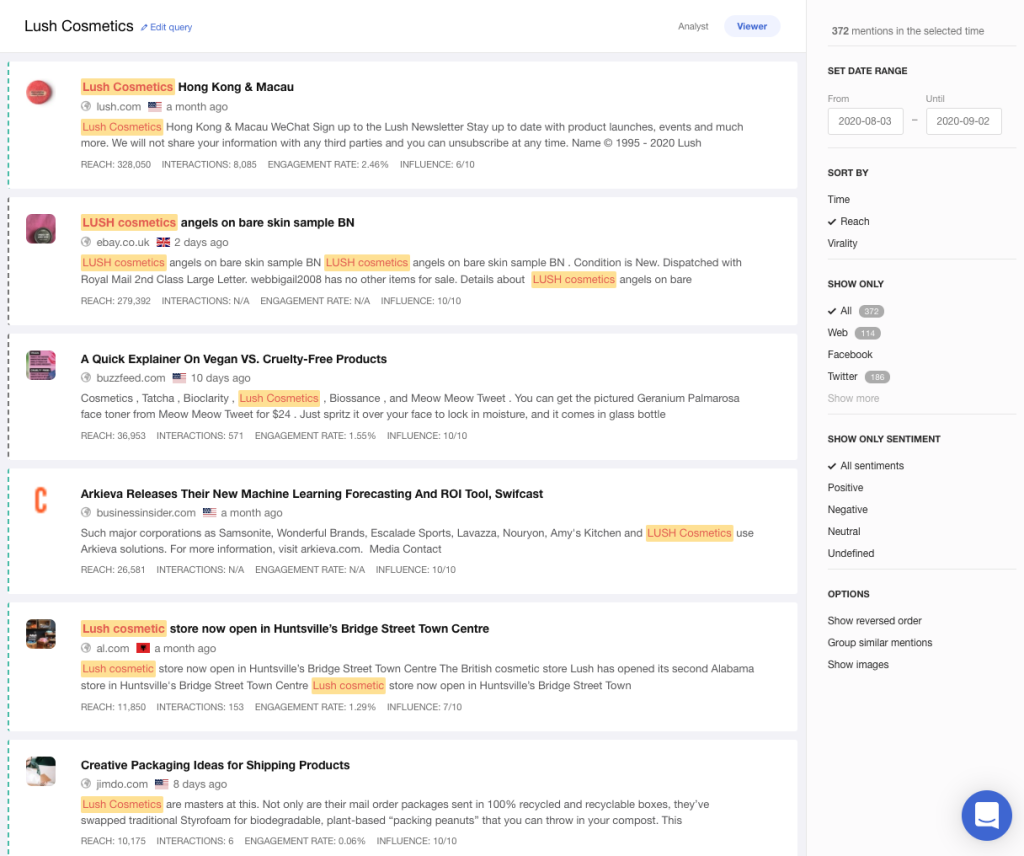
Of course, you can also easily filter the feed if it gets too crowded. In the right-hand toolbar you can:
- Set date range
- Sort by time, reach, or virality
- Show only mentions from a certain source
- Show only a certain sentiment
- Choose options to:
- Show reversed order
- Group similar mentions
- Show images
The great thing about filters is that they can show you a completely new perspective on your mentions, depending on your chosen options.
Scrolling through all the mentions will enable you to easily spot emerging trends across all your outlets and sources, even without looking at the analytics.
#2 The ability to engage directly with your target audience, even if they haven’t tagged you
As we’ve mentioned, any post in which your keyword is mentioned will be fully displayed in your feed. But, you might not know that you can click on that mention and open it on the platform it originated from.
Remember our first example, a user casually chatting to a friend on Twitter about Lush Cosmetics but has not tagged the brand? That happens a lot. 96% of conversations about brands happen outside official brand channels and without tagging the brand in question.
Imagine the surprise factor if Lush Cosmetics engaged with someone who did not expect a direct answer, hence the lack of a tag. So many success stories could stem from this scenario, many of which we’ll discuss shortly.
#3 Valuable audience behavior insights
Gaining a deep understanding of your target audience is surely one of the most impactful benefits of social listening.
If you don’t know how your audience feels about your brand, you can’t engage with them effectively. But when you do, you can tailor your strategy to fit their liking and improve the receptiveness of your content and overall efforts.
How to do that, you may ask? Media monitoring reports are the answer.
What happens in the background is that while the tool tracks your keywords across millions of online sources, it also creates ample data analytics based on the results.
For instance, you could learn which channels your audience uses most to discuss a certain topic. Then, amplify your marketing efforts there.
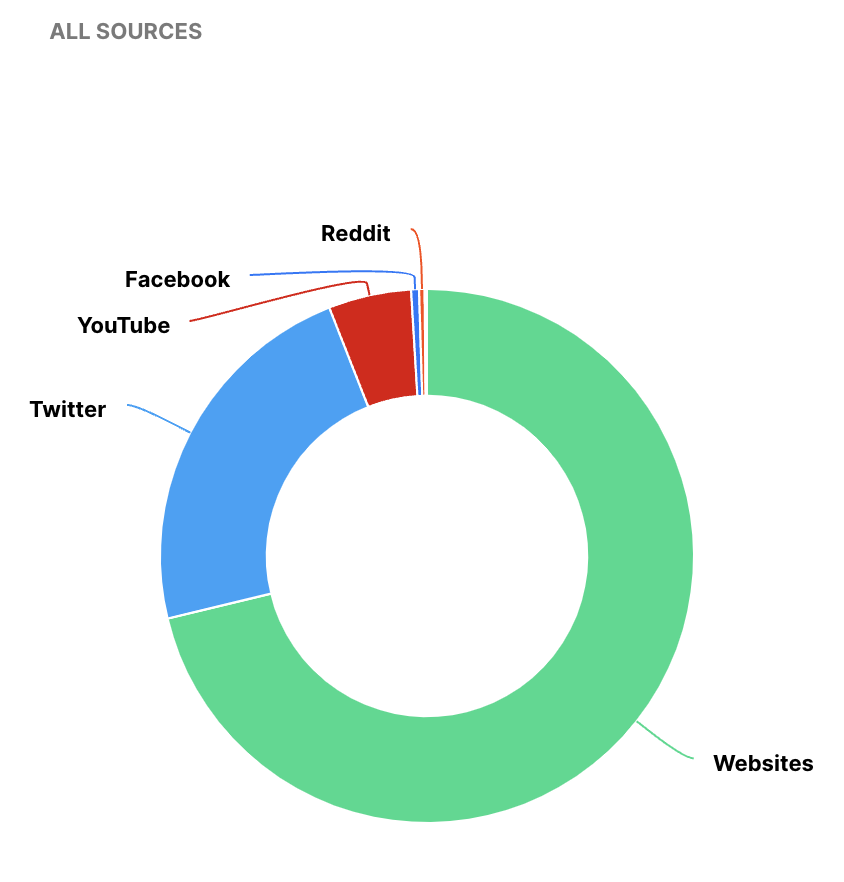
Or, you could detect that your brand sentiment changes over time, depending on which type of content you post.
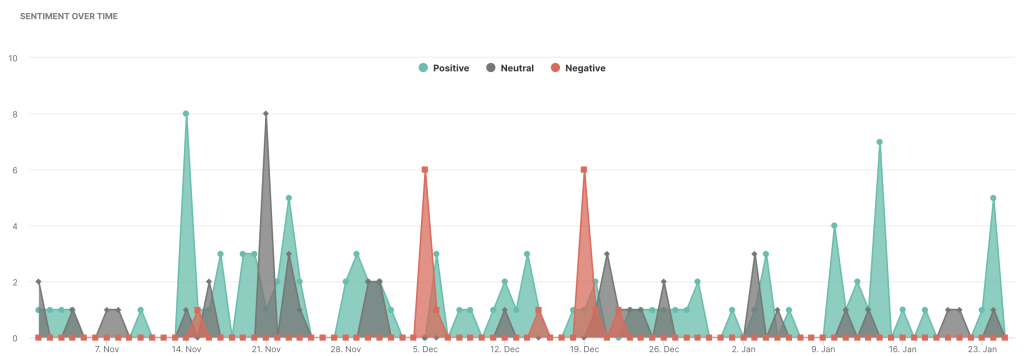
It all comes down to listening to your audience’s needs, interests, and preferences. Thus you can optimize your efforts to ensure the best results.
Read: All you need to know about brand sentiment analysis
#4 Crisis management and prevention
An increasing amount of buzz about your brand might sound good in theory. But what if that buzz is a crisis in the making?
We live in a world of peak social media activity, consumer empowerment, and easily accessible and shareable information. All of these can have a serious impact on your brand reputation.
Regardless of the company size, niche, or any other factor, no brand is untouchable when it comes to crises. But you can easily mitigate a crisis or completely prevent one by turning on real-time alerts.
You’ll get notified the moment a mention of your brand appears online. Hence, you can stay on top of things and be proactive.
As a result, if you identify an issue as it emerges, you can easily react in an informed, effective, and extremely quick way. The speed of your response is what can make or break your brand during a crisis. Why not make it as swift as possible?
#5 Lead generation
Oftentimes brands overlook the opportunities that lie in social listening, with one of the most prominent ones being lead generation. This method is very effective, as it’s a personalized approach responding directly to your lead’s needs.
Social listening enables you to track down people who are easily:
- Seeking advice or recommendations for a product or service like yours,
- Interested specifically in your product or service,
- Unsatisfied customers that use a competitor’s product or service.
For instance, a chocolate brand might track ‘birthday gift ideas‘. Someone with a shoe brand might identify users looking for ‘best running shoes‘.
Depending on your industry or niche, you may adjust your queries to find the right fit for your brand. When you do, you can engage with the user. Then, offer a solution to their problem.
#6 Finding influencers and brand advocates
Another great benefit of social listening is the ease of identifying relevant industry or topic influencers.
When monitoring, you might notice some users are much more active or engaged than others. Sometimes they will be popular influencers, and sometimes they’re regular users who have the potential to become future brand ambassadors.
Regardless, your social listening tool should make finding the right influencer simple. For instance, Determ has an entire dashboard dedicated to Top influencers, who are sorted in the tool by:
- Number of mentions,
- Source,
- Reach,
- Sentiment.
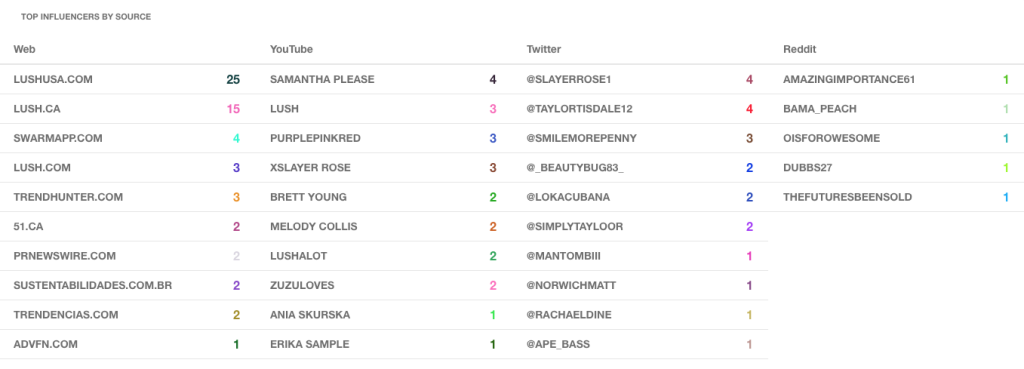
The example above is again a result of the ‘Lush Cosmetics’ monitoring. Clicking on any of these influencers opens a list of all their posts mentioning your query.
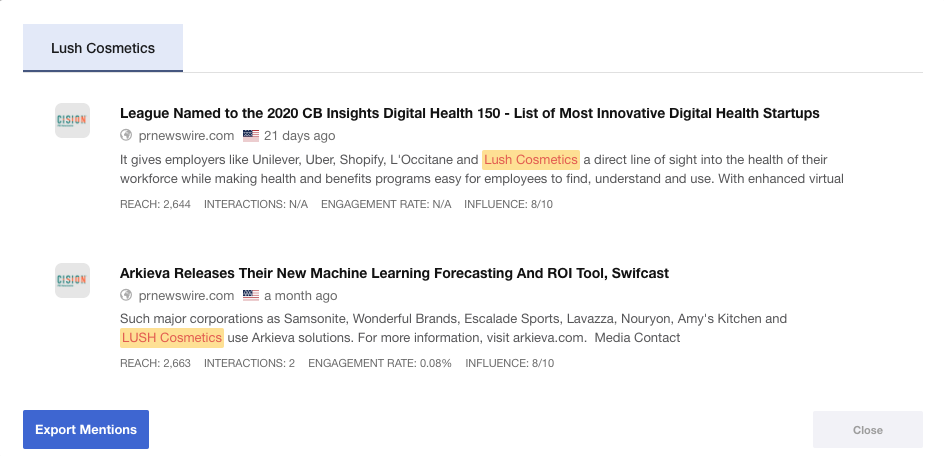
Having such an overview will allow for effective market research and aid in choosing the best fit for your brand based on the content they post.
#7 Improving your online customer support
In order to provide excellent customer service, one of the most important skills is the ability to listen. And when you do listen to your customers, you can learn so much about their wants, needs, and potential pain points.
We’ve already mentioned people often go online to get advice on certain products and services.
But even more than that, they love to share their experiences and opinions with friends and followers. At one point or another, those will be about your brand, and they might not tag you or reach out to you directly.
Social listening makes identifying such posts easy. And, just as importantly, it enables you to respond fast since mention tracking is done in real-time. Once again, speed is essential when resolving online customer issues.
Not only do you thus provide a solution to the customer’s challenge, but you also show others that you are willing to provide the utmost customer experience.
Read: 10 Steps to Manage Negative Online Reviews
#8 Content marketing inspiration
It’s always nice to get fresh content ideas. And, yes, we all have our customers in mind when creating something new. But, marketers can get so deeply involved with a certain topic, they stray away from the customer’s perspective.
To prevent that, and get the best content marketing inspiration, turn to social listening. Insights from online conversations will be your best guide for optimizing your strategy and providing customers with the content they want and need.
For example, you can use the Word cloud chart to detect which words people use the most when mentioning your brand. The size of the word represents the number of mentions – the bigger the word, the bigger the number of mentions.
Let’s use Lush Cosmetics as an example once again.
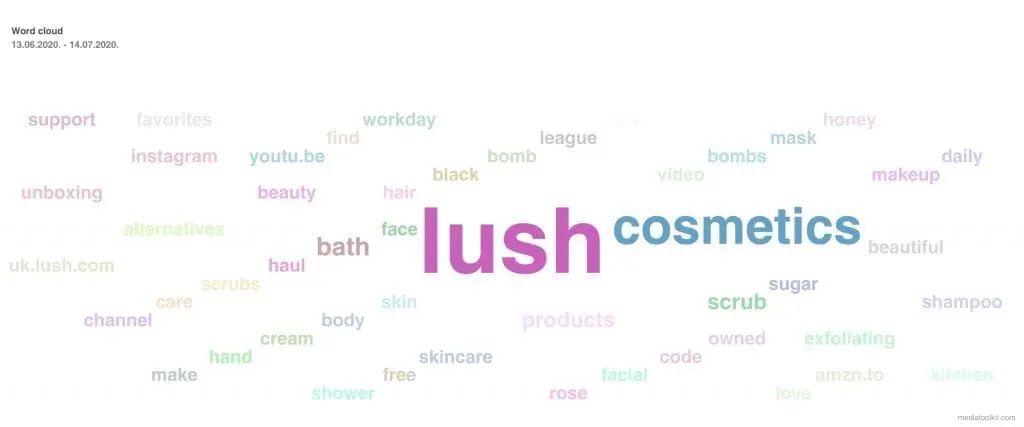
Based on all the keywords mentioned alongside Lush, the brand might notice people are looking for more information on a topic they haven’t covered yet, so they’ll produce content about it.
These keywords can also inspire campaign slogans, hashtags, and other creative elements – empowered by your customers.
#9 Keeping up with your competitors
Tracking your competitors might be just as important as tracking your brand. There are several reasons for this:
- Your competitor’s business moves might impact your own brand, so it’s better to anticipate them early.
- Knowing your competitor’s strengths and weaknesses means you can identify opportunities and threats for your own brand.
- By keeping track of their media coverage and influencers they work with, you can easily reach out to them and offer your product or service instead.
- It’s easier (and cheaper) to track their communication strategy and learn from their successes and failures than to invest your budget into testing new content or approaches. Your ideal personas are similar so they might react similarly, too.
- Monitoring posts and mentions by their unsatisfied customers is an incredible chance for you to generate leads and turn them into customers.
Also, tracking both your and competitor’s brand enables you to precisely measure how you stack up against each other in terms of visibility and receptiveness.
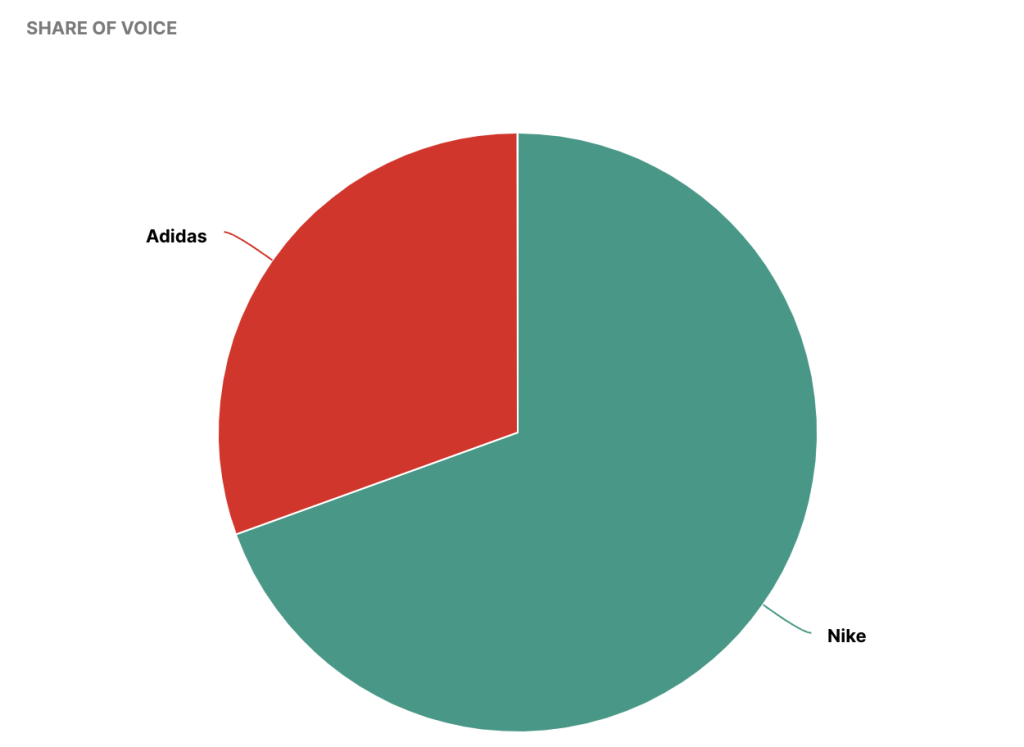
Take advantage of the Competitive analysis to compare where you and your competitors stand, and then figure out how to surpass them if they’re in the lead.
Social Listening Examples
To really understand the process, let’s take a look at some real-life social listening examples and ideas.
Take Wendy’s, for instance. Back in 2010, this fast-food restaurant company debuted their new fries marketed as containing sea salt, rather than your standard salt, and had massive success.
Before the launch, Wendy’s tracked online discussions about the rising concerns about high sodium intake. They learned that consumers perceived ‘sea salt’ much more positively than ‘salt’ or ‘sodium’. The predominant positive sentiment of ‘sea salt’ encouraged them to create a campaign focused on more positive health associations with their new fries.
As a result, customers were delighted and the sales of their french fries improved.
This is an excellent example of how social listening can provide growth opportunities. They are not necessarily limited to tracking the company name directly but also include relevant topics and keywords.
From tracking to growth
There are tons of social listening examples out there. Tracking a phrase such as ‘gift ideas’ might allow a chocolate brand to engage directly with customers. Tracking online mentions of ‘best gift ideas’, for instance, might enable them to identify users looking for such advice and then suggest their product as a solution.
A sports shoe brand might track online conversations about running shoes to discover their potential customers’ needs and preferences. Based on that, they can improve their product or craft a strategy tailored to their target audience.
Online conversations can also serve as inspiration for various brands when it comes to content creation. Learning which topics and keywords are most mentioned alongside your main query can indicate consumers are interested in more on those specific subtopics.
As you can see, listening to the target audience’s feedback and topics of interest might open many doors for any brand. Being proactive and recognizing trends and patterns will allow you to use insights to guide your strategy and easily define actionable steps, just like Wendy’s. With a bit of creativity, the possibilities are endless.
Social Listening Strategy
We’ve mentioned numerous social listening strategies throughout this blog, so you probably get the gist by now. Now, let’s recap the ways you can enrich your social listening strategy immediately:
- Stay on top of all your brand mentions in real time and from one place
- Acquire the most genuine and up-to-date feedback
- Gain insights into online conversations mentioning your brand
- Track the volume of online conversations and changes in sentiment
- Create content based on your audience’s wants, needs, and pain points
- Identify emerging trends and patterns
- Conduct market research to guide your strategy
- Create meaningful engagement with your target audience
- Respond directly to your customers, even without them tagging you
- Respond to unsatisfied competitor’s customers
- Generate leads by monitoring relevant keywords and phrases
- Identify influencers to promote your brand
- Resolve any customer issues that might occur
- Keep up with industry news, trends, and competitors to anticipate changes that might affect your business.
The next step is finding a tool to enable all the above-mentioned.
Best Social Listening Tools
Now that you know everything about social listening, it’s time to pick the right tool for your needs. Here are the 5 social listening tools most often quoted as favorites (not listed in any particular order):
Socialbakers
Socialbakers is a social media marketing platform that monitors over 8 million business profiles across all major platforms. That includes Facebook, Instagram, Twitter, LinkedIn, Youtube, Pinterest, Google+, and VK.com.
Socialbakers enables you to gain vital insights into your audience. That way you can gain control of your brand reputation, as you are able to always be in the know about what is being said about your brand online and directly engage in those conversations.
It also automates all content and comments tagging to let you access valuable data instantly. A free trial is available, while the entry plan is priced at 200$/month for 10 profiles or 400$/month for 20 profiles.
Determ
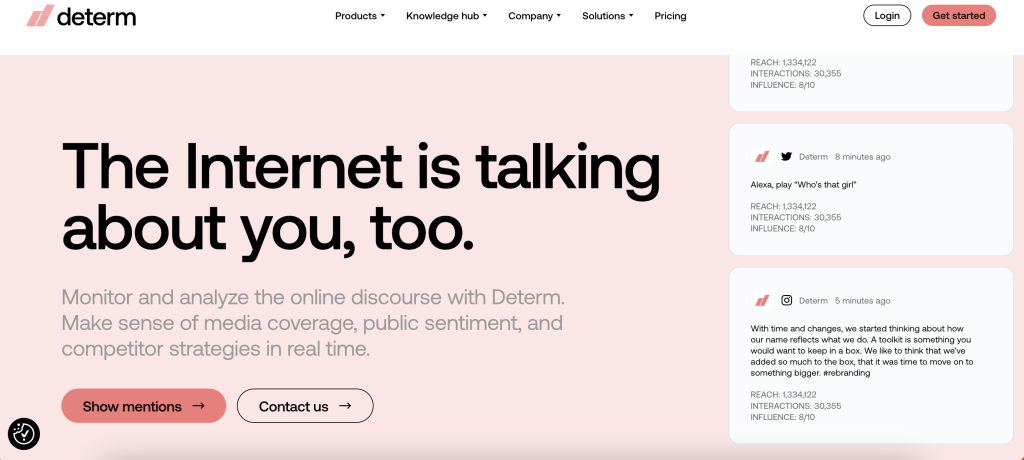
It is an award-winning media monitoring and social listening tool that helps users to be notified immediately when their company, products, or services are mentioned in any language across 100+ million online sources.
Businesses of all sizes can track brand mentions and build their strategy on valuable audience insights, be it a web article, social media post, or blog comment.
Advanced data analytics allows for measuring reach, sentiment, and engagement, identifying influencers, top locations, languages, and top-performing channels. More than 2000 charts and dashboards can be fully customized to get unique datasets and gain that competitive edge.
And the best part? The number of users, keywords, and mentions are unlimited on all plans.
Determ doesn’t have the pricing info available online, but the prices are available upon request.
Buffer
Buffer is a publishing, analytics, and engagement platform, your go-to ally for social media management.
With Buffer, you can visually plan and schedule your social media content and campaigns to drive better engagement on social media channels.
It can also be used to analyze your campaigns and measure their success. Besides these features, the tool allows you to directly engage in conversations with your audience in the replies from one centralized dashboard.
A 14-day free trial is available. If you enjoy the platform, you can switch to paid plans that start from 15$/month to publish and another 35$/month to analyze (both include 8 social media accounts).
Synthesio
Synthesio is a social listening platform that captures social media intelligence from 195 countries in 80+ languages.
It provides great audience insights and is used by brands to rationalize and understand consumer motivation and measure the impact of online conversations against their business goals.
With Synthesio, you can track likes, replies, views, favorites, retweets, and shares from Facebook, Twitter, Instagram, and YouTube directly on your social media listening dashboard.
There is no free trial or pricing information available at the time of writing this blog, but you can request a demo to see the tool in action.
Keyhole
Keyhole offers automated social media analytics for agencies, marketers, journalists, and executives.
It measures real-time and historical social media data and illustrates information in easy-to-read graphs and layouts that simplify reporting and strategizing.
Keyhole tracks hashtags, accounts, keywords, and URLs on Facebook, Twitter, Youtube, and Instagram. It can also be used for real-time campaign monitoring and optimization, brand monitoring and optimization, and data-driven market and competitor research.
You can test out during the free trial, while the paid plans start from 49$/month for either social media and account analytics or social listening and campaign tracking.
To Conclude
Epictetus’s quote perfectly sums up this blog: “We have two ears and one mouth so that we can listen twice as much as we speak.”
Keep this in mind when crafting your communication strategy. Equipped with all this knowledge on social listening, all there is left to do is pick the right tool and get straight to growing your business with the help of media intelligence.
Want to get started with social listening?
From brand monitoring and reputation management to ample data analytics and audience insights, Determ is the only social listening tool you’ll ever need. Sign up for your free trial today.



